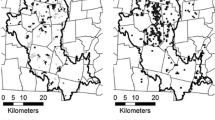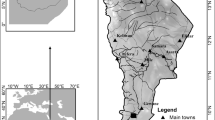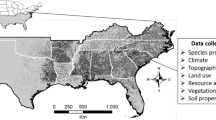Abstract
Natural and anthropogenic site characteristics play a role in determining the current distribution of invasive plant species. An understanding of these characteristics can be used to prioritize areas for monitoring and control efforts and to determine appropriate management actions to lower site invasion risk. We used species distribution models to look for attributes associated with invasion and to determine the extent to which these attributes varied across a suite of species. We modeled the presence-absence of 11 invasive plant species along riparian areas in the northwestern United States using the model Random Forests. We found that climate variables were most important for predicting species distributions across the large study area and factors related to nutrients, land cover, and disturbance had moderate importance. We also found that there was a general pattern related to invasion for almost all species. Invasion was more likely to occur at hotter, drier sites near roads in unforested areas. In addition, high nutrient levels and proximity to streams with lower baseflow values also generally increased the likelihood that at least one invasive species would be present. Examining patterns across a broad range of regions can help suggest general mechanisms of invasion as well as provide region-specific management recommendations.


Similar content being viewed by others
References
Allen M, Shea K (2006) Spatial segregation of congeneric invaders in central Pennsylvania, USA. Biol Invasions 8:509–521
Allen J, Brown C, Stohlgren T (2009) Non-native plant invasions of United States National Parks. Biol Invasions 11:2195–2207
Alpert P, Bone E, Holzapfel C (2000) Invasiveness, invasibility and the role of environmental stress in the spread of non-native plants. Perspect Plant Ecol Evol Syst 3:52–66
Bakker JP, Berendse F (1999) Constraints in the restoration of ecological diversity in grassland and heathland communities. Trends Ecol Evol 14:63–68
Bendix J (1997) Flood disturbance and the distribution of riparian species diversity. Geogr Rev 87:468–483
Brooks ML (2003) Effects of increased soil nitrogen on the dominance of alien annual plants in the Mojave Desert. J Appl Ecol 40:344–353
Catford JA, Vesk PA, White MD, Wintle BA (2011) Hotspots of plant invasion predicted by propagule pressure and ecosystem characteristics. Divers Distrib 17:1099–1110
Catford JA, Vesk PA, Richardson DM, Pyšek P (2012) Quantifying levels of biological invasion: towards the objective classification of invaded and invasible ecosystems. Glob Change Biol 18:44–62
Chong GW, Otsuki Y, Stohlgren TJ, Guenther D, Evangelista P, Villa C, Waters A (2006) Evaluating plant invasions from both habitat and species perspectives. West N Am Naturalist 66:92–105
Chytry M, Pyšek P, Wild J, Pino J, Maskell LC, Vilà M (2009) European map of alien plant invasions based on the quantitative assessment across habitats. Divers Distrib 15:98–107
Chytrý M, Jarošík V, Pyšek P, Hájek O, Knollová I, Tichý L, Danihelka J (2008) Separating habitat invasibility by alien plants from the actual level of invasion. Ecology 89:1541–1553
Coffin AW (2007) From roadkill to road ecology: a review of the ecological effects of roads. J Transp Geogr 15:396–406
Colautti RI, Grigorovich IA, MacIsaac HJ (2006) Propagule pressure: a null model for biological invasions. Biol Invasions 8:1023–1037
Cutler D, Edwards T Jr, Beard K, Cutler A, Hess K, Gibson J, Lawler J (2007) Random Forests for classification in ecology. Ecology 88:2783–2792
Daly C, Halbleib M, Smith JI, Gibson WP, Doggett MK, Taylor GH, Curtis J, Pasteris PP (2008) Physiographically sensitive mapping of climatological temperature and precipitation across the conterminous United States. Int J Climatol 28:2031–2064
Davis MA, Grime JP, Thompson K (2000) Fluctuating resources in plant communities: a general theory of invasibility. J Ecol 88:528–534
Diaz S, Lavorel S, McIntyre S, Falczuk V, Casanoves F, Milchunas DG, Skarpe C, Rusch G, Sternberg M, Noy-Meir I, Landsberg J, Zhang W, Clark H, Campbell BD (2007) Plant trait responses to grazing—a global synthesis. Glob Change Biol 13:313–341
Díaz S, Noy-Meir I, Cabido M (2001) Can grazing response of herbaceous plants be predicted from simple vegetative traits? J Appl Ecol 38:497–508
Eidenshink J, Schwind B, Brewer K, Zhu Z, Quayle B, Howard S (2007) A project for monitoring trends in burn severity. Fire Ecol 3:3–21
Evangelista P, Kumar S, Stohlgren T, Jarnevich C, Crall A, Norman J III, Barnett D (2008) Modelling invasion for a habitat generalist and a specialist plant species. Biodiv Lett 14:808–817
Fielding A, Bell J (1997) A review of methods for the assessment of prediction errors in conservation presence/absence models. Environ Conserv 24:38–49
Freeman EA, Moisen GG (2008) A comparison of the performance of threshold criteria for binary classification in terms of predicted prevalence and kappa. Ecol Model 217:48–58
Gelbard JL, Harrison S (2003) Roadless habitats as refuges for native grasslands: interactions with soil, aspect, and grazing. Ecol Appl 13:404–415
Gesch D, Evans G, Mauck J, Hutchinson J, Carswell Jr. WJ (2009) The national map—elevation: US Geological Survey Fact Sheet 2009–3053
Google Inc. (2010) Google Earth (Version 5.2) [Software]. Available from http://www.google.com/earth/index.html
Hansen M, Clevenger A (2005) The influence of disturbance and habitat on the presence of non-native plant species along transport corridors. Biol Conserv 125:249–259
Hawbaker T, Radeloff V (2004) Roads and landscape pattern in northern Wisconsin based on a comparison of four road data sources. Conserv Biol 18:1233–1244
Henderson RC, Archer EK, Bouwes BA, Coles-Ritchie MS, Kershner JL (2005) PACFISH/INFISH biological opinion (PIBO): effectiveness monitoring program seven-year status report 1998 through 2004, General Technical Report RMRS-GTR-162. USDA Forest Service Rocky Mountain Research Station, Fort Collins
Hobbs RJ, Huenneke LF (1992) Disturbance, diversity, and invasion: implications for conservation. Conserv Biol 6:324–337
Hobbs RJ, Humphries SE (1995) An integrated approach to the ecology and management of plant invasions. Conserv Biol 9:761–770
Hosmer DW, Lemeshow S (2000) Applied logistic regression, 2nd edn. Wiley, New York
Ibáñez I, Silander J Jr, Wilson A, LaFleur N, Tanaka N, Tsuyama I (2009) Multivariate forecasts of potential distributions of invasive plant species. Ecol Appl 19:359–375
Jansen F, Ewald J, Zerbe S (2011) Ecological preferences of alien plant species in North-Eastern Germany. Biol Invasions 13:2691–2701
Jefferies RL, Maron JL (1997) The embarrassment of riches: atmospheric deposition of nitrogen and community and ecosystem processes. Trends Ecol Evol 12:74–78
Lavergne S, Molofsky J (2004) Reed canary grass (Phalaris arundinacea) as a biological model in the study of plant invasions. Crit Rev Plant Sci 23:415–429
Liaw A, Wiener M (2002) Classification and regression by random forest. R News 2:18–22
Lonsdale WM, Lane AM (1994) Tourist vehicles as vectors of weed seeds in Kakadu National Park, Northern Australia. Biol Conserv 69:277–283
Loo S, Mac Nally R, O’Dowd D, Thomson J, Lake P (2009) Multiple scale analysis of factors influencing the distribution of an invasive aquatic grass. Biol Invasions 11:1903–1912
Lovett-Doust J, Lovett-Doust L, Groth AT (1990) The biology of Canadian weeds: 95. Ranunculus repens. Can J Plant Sci 70:1123–1141
Ludington S, Moring BC, Miller RJ, Stone PA, Bookstrom AA, Bedford DR, Evans JG, Haxel GA, Nutt CJ, Flyn KS, Hopkin MJ (2007) Preliminary integrated geologic map databases for the United States Western States: California, Nevada, Arizona, Washington, Oregon, Idaho, and Utah, Open-File Rep. 2005–1305. US Geological Survey, Reston
Milbau A, Stout J, Graae B, Nijs I (2009) A hierarchical framework for integrating invasibility experiments incorporating different factors and spatial scales. Biol Invasions 11:941–950
Milchunas D, Sala O, Lauenroth WK (1988) A generalized model of the effects of grazing by large herbivores on grassland community structure. Am Naturalist 132:87–106
Ohlemüller R, Walker S, Bastow Wilson J (2006) Local vs regional factors as determinants of the invasibility of indigenous forest fragments by alien plant species. Oikos 112:493–501
Olson JR, Hawkins CP (2012) Predicting natural base-flow stream water chemistry in the western United States. Water Resour Res 48:W02504
Parendes L, Jones J (2000) Role of light availability and dispersal in exotic plant invasion along roads and streams in the HJ Andrews Experimental Forest, Oregon. Conserv Biol 14:64–75
Perry L, Blumenthal D, Monaco T, Paschke M, Redente E (2010) Immobilizing nitrogen to control plant invasion. Oecologia 163:13–24
Pimentel D, Zuniga R, Morrison D (2005) Update on the environmental and economic costs associated with alien-invasive species in the United States. Ecol Econ 52:273–288
Pyšek P, Richardson DM (2010) Invasive species, environmental change and management, and health. Ann Rev Environ Res 35:25–55
Pyšek P, Jarošík V, Kucera T (2002) Patterns of invasion in temperate nature reserves. Biol Conserv 104:13–24
Pyšek P, Jarošík V, Hulme PE, Kühn I, Wild J, Arianoutsou M, Bacher S, Chiron F, Didžiulis V, Essl F (2010) Disentangling the role of environmental and human pressures on biological invasions across Europe. Proc Natl Acad Sci 107:12157
R Development Core Team (2010) R: a language and environment for statistical computing. R Foundation for Statistical Computing Vienna
Richardson D, Pyšek P (2006) Plant invasions: merging the concepts of species invasiveness and community invasibility. Prog Phys Geogr 30:409–431
Richardson DM, Pyšek P, Rejmanek M, Barbour MG, Panetta FD, West CJ (2000) Naturalization and invasion of alien plants: concepts and definitions. Divers Distrib 6:93–107
Richardson D, Holmes P, Esler K, Galatowitsch S, Stromberg J, Kirkman S, Pyšek P, Hobbs R (2007) Riparian vegetation: degradation, alien plant invasions, and restoration prospects. Divers Distrib 13:126–139
Sandel B, Dangremond EM (2012) Climate change and the invasion of California by grasses. Glob Change Biol 18:277–289
Schwede DB, Dennis RL, Bitz MA (2009) The watershed deposition tool: a tool for incorporating atmospheric deposition in water quality analyses. J Am Water Resour Assoc 45:973–985
Shea K, Chesson P (2002) Community ecology theory as a framework for biological invasions. Trends Ecol Evol 17:170–176
Skinner K, Smith L, Rice P (2000) Using noxious weed lists to prioritize targets for developing weed management strategies. Weed Sci 48:640–644
Smakhtin VU (2001) Low flow hydrology: a review. J Hydrol 240:147–186
Stohlgren TJ, Barnett D, Flather C, Kartesz J, Peterjohn B (2005a) Plant species invasions along the latitudinal gradient in the United States. Ecology 86:2298–2309
Stohlgren TJ, Guenther DA, Evangelista PH, Alley N (2005b) Patterns of plant species richness, rarity, endemism, and uniqueness in an arid landscape. Ecol Appl 15:715–725
Theoharides KA, Dukes JS (2007) Plant invasion across space and time: factors affecting nonindigenous species success during four stages of invasion. New Phytol 176:256–273
Thomaes A, Kervyn T, Maes D (2008) Applying species distribution modelling for the conservation of the threatened saproxylic Stag Beetle (Lucanus cervus). Biol Conserv 141:1400–1410
US Census Bureau (2009) US Census 2000 TIGER/Line files machine-readable data files. US Census Bureau, Washington
Vasquez E, Sheley R, Svejcar T (2008) Creating invasion resistant soils via nitrogen management. Invasive Plant Sci Manag 1:304–314
Wolock DM (2003) Base-flow index grid for the conterminous United States. US Geological Survey, Reston, Virginia
Acknowledgments
Thanks to J. Olson, R. Hill, R. Lokteff, A. Hill, and P. Ebertowski for data assistance. B. Roper, E. Archer, and C. Hawkins helped refine study questions and analysis. Members of the Kettenring lab, especially L. Long, N. Hough-Snee, E. Hazelton, and A. Sweetman, led to manuscript improvement. Funding was provided by the S.J. Quinney Masters Fellowship at Utah State University and the USDA Forest Service.
Author information
Authors and Affiliations
Corresponding author
Electronic supplementary material
Below is the link to the electronic supplementary material.
Rights and permissions
About this article
Cite this article
Menuz, D.R., Kettenring, K.M. The importance of roads, nutrients, and climate for invasive plant establishment in riparian areas in the northwestern United States. Biol Invasions 15, 1601–1612 (2013). https://doi.org/10.1007/s10530-012-0395-6
Received:
Accepted:
Published:
Issue Date:
DOI: https://doi.org/10.1007/s10530-012-0395-6




